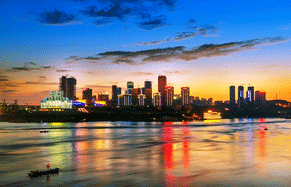Jilin sets development goals
Targets set for quality of life, project construction
The municipal government of Jilin city, Northeast China's Jilin province, has set clear targets for 2015 as it endeavors to restructure its economy and promote social development.
The targets include goals for project construction, raising capital, attracting talent, urban construction and management as well as improvements to public quality of life.
At the beginning of the 12th Five-Year Plan (2011-2015), the city achieved a GDP of 227.8 billion yuan ($36 billion), an increase of 26.5 percent over the year previous.
The city achieved full tax and fee revenue of 24.5 billion yuan in 2011, an increase of 27.5 percent over the year previous.
Large-scale industrial enterprises generated a total profit of 280 billion yuan, increasing 38 percent year on year.
According to statistics, the per capita disposable income of urban residents rose by 14 percent to reach nearly 19,300 yuan last year, and the per capita net income for people in the countryside grew to more than 7,649 yuan, an increase of 16 percent.
To realize the development goals, the government has set up 10 functional zones in the city, and it is continuously speeding up the development of its traditional pillar industries while giving financial and technological support to profitable new industries.
The 10 functional zones are - the Jilin Auto Industry Park in the Jilin High-tech Industrial Development Zone, the Jilin Economic and Technical Development Zone, the Jilin Chemical Engineering Circular Economy Demonstration Park, the Jinzhu Industrial Zone, the High-Tech Zone of Northern Jilin, the Hadawan Modern Service Industry Zone, the New Zone in Southern Jilin, the Songhuahu Scenic Spot, the Beidahu Sports and Tourism Zone as well as the Jilin China-Singapore Food Zone.
As the core of Jilin's industrial development, the total area of the 10 industrial zones exceeds 600 square kilometers, according to the government's plan.
By 2015, the zones together are expected to generate 80 percent of the city's economic aggregate, with a population of 50,000.
As a city in China's old industrial base, Jilin must continue developing its traditional pillar industries, especially the petrochemical industry, as it works to restructure its economy.
Steady development and a solid industrial foundation as well as its edge in the use of new technology has helped the city's petrochemical industry rejuvenate its traditional sectors and expand into emerging ones.
In order to develop the local economy and upgrade its industries, the Jilin municipal government has provided active support to enterprises to develop petrochemical programs, leading to a renewed surge in investment.
PetroChina subsidiary Jilin Petrochemical Company,the city's leading company in the industry, has seen robust growth in recent years and mobilized other local companies to grow. At present, the company's biomass fuel ethanol production capacity ranks the first in the world, and its acrylonitrile capacity is No 1 in Asia.
Additionally, a batch of new industries, such as carbon fibers, advanced equipment manufacturing and electronics, have also been undergoing rapid development in recent years, injecting new vitality into the city's economic growth.
The development of new industries also helps to attract and cultivate industrial experts and technicians for the city. This talent will continue to provide technological support to the nation's carbon fiber industry.
liumingtai@chinadaily.com.cn
(China Daily 06/21/2012 page12)




















